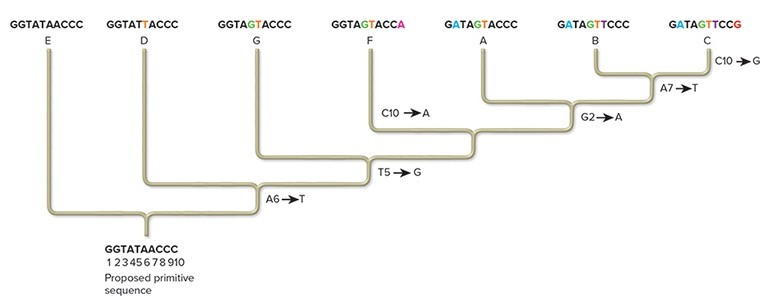What nucleotide change is a shared derived character for species A, B, and C, but not for species G? Note: A,T,G, and C refer to nucleotide bases, and the numbers refer to the position of the base in the nucleotide sequences.For example, A6 refers to an adenine at the sixth position.
Note: A,T,G, and C refer to nucleotide bases, and the numbers refer to the position of the base in the nucleotide sequences.For example, A6 refers to an adenine at the sixth position.
A. Changing the fifth T to a G is common to species A, B, and C, but not to species G.
B. Changing the second G to an A is common to species A, B, and C, but not to species G.
C. Changing the second G to an A and the fifth T to a G is common to species A, B, and C, but not to species G.
D. Changing the second G to a T is common to species A, B, and C, but not to species G.
E. None of these show a change in derived characteristics for A, B, and C that are not found in G.
Answer: B
You might also like to view...
Which statement factors into artificial but not natural selection?
A. Most organisms are capable of producing more offspring than typically survive. B. Phenotypic variation can influence reproductive success. C. Phenotypic variation within a species is due in part to inherited characteristics. D. Phenotypic variation exists within populations. E. Phenotypic variation of a species has variable appeal to humans interested in that species.
The dinosaurs and many other animals became extinct at the end of the
A) Cambrian period. B) Permian period. C) Cretaceous period. D) Pleistocene epoch.
Streptococcus agalactiae is associated with which of the following diseases?
A) neonatal bacteremia B) neonatal meningitis C) neonatal pneumonia D) both neonatal bacteremia and neonatal meningitis E) neonatal bacteremia, neonatal meningitis, and neonatal pneumonia
Which of the following is true of the genetic cross shown in the figure?
daughters will be carriers. b. Their sons have a 50 percent chance of being carriers. c. Their sons have a 50 percent chance of having the disorder. d. Their daughters have a 50 percent chance of having the disorder.